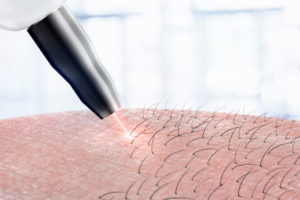Doctor James Schinazi holds a European inter-university degree in Medical Lasers (Paris Descartes) just like all of the assistant doctors who carry out laser hair removal and the other laser treatments in the practice.

The hair is born in the bottom of the hair follicle.
Each hair is characterised by:
It is important to know that in one given area, all hairs:
Therefore, every hair follows its own cycle, which is why just one laser session is not enough to treat all the hairs in the same area
The laser emits monochromatic (one colour) and unidirectional light energy.
In the case of laser epilation, the target will be the melanin which absorbs the energy emitted by the laser and transforms it into heat, which is conducted right along the hair strand to its root.
When it reaches the bulb, the heat will have a destructive effect on this hair root and will thus prevent any later growth.
What is good about using a laser is its precision in reaching its target (melanin and hair bulb) without damaging the surrounding skin structures.
Since melanin is the lasers’ target and it is responsible for the hair colour, white and blond hairs cannot be treated using a laser (because they lack melanin).
With the considerable development of new technologies, we now have lasers that can treat almost all skin types (namely thanks to Nd-Yag and Alexandrite lasers).
Since the hair and melanin are the lasers’ targets, you must not wax or pluck the hairs between sessions. We recommend shaving around 48 hours before the next session (or even cutting the hairs with facial scissors).
The hairs in the anagen phase are the most sensitive to laser treatment because they have high levels of melanin and are more superficial.
Because all the hairs in the same zone are not in the same phase, it is important to repeat the treatments regularly.
The first session generally allows us to bring all the hairs in one zone into the same phase for the following session.
Depending on the area to be treated, the sessions are spaced 4 to 8 weeks apart on average, because the hairs do not grow at the same speed from one area to the next.
The total number of sessions depends on:
On average, we need between 5 and 8 sessions of laser hair removal to treat one area.
We sometimes need to carry out a maintenance session every year or every other year to prevent any regrowth.
But after a complete and effective laser treatment, if there is any regrowth, the hair quality will have changed (finer and more superficial hairs) and so you will only need some short “retouch” sessions.
As required by law in France, laser hair removal can only be performed by doctors in their practice.
Both the patient and the doctor wear special glasses to protect their eyes from the laser beams.
We divide the treatment area into sections and analyse the hairs in order to enter the correct settings on the machine.
The laser’s handpiece is positioned in contact with the patient’s skin and emits the light pulse. You might feel a tingling sensation, like the flick of an elastic band or a short burn, but this is well tolerated thanks to the cold that is applied at the same time as the laser beam.
The doctor seeks out the hairs, which curl and coagulate, leading to the formation of small patches of swelling (temporary, lasting just a few hours). This is what we call the perifollicular reaction.
On vary rare occasions, small scabs or blisters may appear, but these disappear very quickly with a suitable treatment (healing cream).
Brown or white marks may also appear some time after the treatment, but these are also temporary (lasting a few weeks or months).
It is vital that patients adhere to the following recommendations in order to avoid any side effects and optimise the treatment to minimise the total number of sessions.
Laser hair removal treatments are carried out by Dr James Schinazi’s assistant doctors:
The fee charged per session depends on the number of areas to be treated.
11, avenue Raymond Poincaré
75116 Paris
The practice is on the ground floor, on the right
Tél : 01 56 62 10 77
contact@docteur-schinazi.com
Parking nearby
Metro ligne 6 et 9 Trocadéro
Bus 22, 32, 63, 82